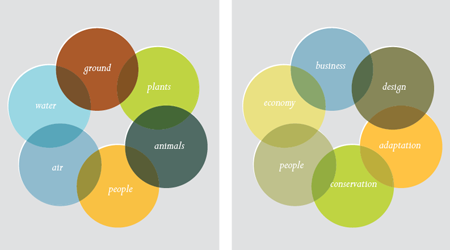
An essay in response to reading Wendell Berry’s “Solving for Pattern.”
Everything in life is connected and yet somehow we, as a species, have lost sight of this. Through scientific discoveries, examinations, and investigations we have “unlocked” the secrets of nature. Instead of a collective humbling or increased respect for this magnificent system, this process has caused us to become more detached and inclined to control that which we consider “wild”. We have “conquered” the earth’s rhythm in many ways—through the built environment, communications infrastructure, transportation, resource management, energy policy etc. Systematically, we are reconfiguring and reorganizing natural resources to suit our idea of what the world should, or could, be.
Individuals are staking claim to what is rightfully all of ours to share. These are limited resources that will run out, we all know this, and yet relatively little is being done that can truly stop it from happening. Westerners are apparently unable to let go of their habits of consumption. To be sure, the earth will be fine. It will long out live us and witness many other forms of life beyond ours. The problem is, however, that I want my kids, and grand kids, to see snow, and maybe even maple trees before they all end up in Canada having migrated along with the cooler climate.
These changing conditions we are currently witnessing are part of something larger and contain something smaller. There are countless systems making up the world we know from microscopic systems to macroscopic systems all layered in, and on top of, one another. There are biological systems, monetary systems, computer systems, governmental systems, railroad systems, education systems, nervous systems, all nested within larger systems and containing smaller systems to form the intricate ecosystem we experience everyday.
Wendell Berry’s Solving for Pattern expounds upon this idea of interrelated systems and the disconnect man has enabled. It exemplifies how we can work to reconnect with the natural cycle through perhaps one of the easiest to comprehend, sustainable agriculture, by following this very simple logic:
What is good for the water is good for the ground, what is good for the ground is good for the plants, what is good for the plants is good for animals, what is good for animals is good for people, what is good for people is good for the air, what is good for the air is good for the water.
With this in mind, farmers have the potential to embrace this pattern and harmonize their agricultural methods on a variety of scales. Though currently unable to compete with the heavily industrialized farming that produces the majority of the food supply, sustainable agriculture’s true assets are in its local distribution, small scale and diversity of production. If all of the farms that used to dot the countrysides were still around employing this idea, it is not hard to imagine that locally grown food would be just as viable as the industrial methods employed today.
I am captivated by the idea of extending this lesson to some of the other systems we encounter everyday, and more specifically, how this model can apply to the design process. In re-reading this article after almost a year I realized there are several overlapping themes that relate directly to my current thesis investigation.
But we must not forget that those human solutions that we may call organic are not natural. We are talking about organic artifacts, organic only by imitation or analogy. Our ability to make such artifacts depends on virtues that are specifically human: accurate memory, observation, insight, imagination, inventiveness, reverence, devotion, fidelity, restraint. Restraint – for us, now – above all: the ability to accept and live within limits; to resist changes that are merely novel or fashionable; to resist greed and pride; to resist the temptation to “solve” problems by ignoring them, accepting them as “trade-offs,” or bequeathing them to posterity. A good solution, then, must be in harmony with good character, cultural value, and moral law.